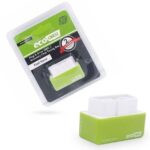Experiencing issues with your Dodge Journey’s check engine light can be concerning, and utilizing an OBD2 scanner is a common first step for diagnosis. Like many Dodge Journey owners, you might be wondering about OBD2 scanner compatibility and the correct procedure for connecting to your vehicle. This article addresses common questions and troubleshooting steps specifically for using an OBD2 scanner with a Dodge Journey.
Understanding OBD2 and Your Dodge Journey
OBD2 (On-Board Diagnostics II) is a standardized system in most cars manufactured after 1996, including the Dodge Journey. It allows you to access vehicle diagnostic information, particularly trouble codes related to the check engine light. These codes can pinpoint potential issues, from minor sensor malfunctions to more significant mechanical problems.
Scanner Compatibility: Is Your Actron CP9575 Compatible?
The Actron CP9575, being an OBD II/EODB scanner, should theoretically be compatible with your 2016 Dodge Journey. The OBD2 standard aims for universal compatibility across makes and models. However, issues can sometimes arise due to software glitches, incorrect connection procedures, or, in rare cases, scanner limitations.
Common Connection Problems and Solutions
The original poster described difficulties getting their Actron CP9575 scanner to connect properly, with the car entering a strange state when attempting connection in “Run” mode. Let’s explore potential causes and solutions:
1. Ignition Mode and Connection Sequence
The correct procedure for connecting an OBD2 scanner often involves specific ignition modes. The user mentioned issues with the “Run” mode. Here’s a typical sequence to try:
- Vehicle Off: Ensure your Dodge Journey is completely turned off.
- Locate the OBD2 Port: This port is usually located under the dashboard on the driver’s side. Refer to your Dodge Journey owner’s manual for the exact location if needed.
- Connect the Scanner: Plug the Actron CP9575 scanner firmly into the OBD2 port.
- Turn Ignition to “Run” (Engine Off): Turn the ignition key to the “Run” position. This powers up the car’s electronics without starting the engine. In push-button start vehicles, this is usually achieved by pressing the start button without pressing the brake pedal.
- Initiate Scanner: Turn on your Actron CP9575 scanner and follow its instructions to begin scanning for codes.
Avoid starting the engine before establishing a connection, as this can sometimes interfere with the diagnostic process.
2. Software and Scanner Updates
While the user mentioned updating their Actron CP9575, it’s crucial to ensure the update was successful and that the scanner software is functioning correctly. Check the manufacturer’s website (Actron in this case) for the latest software versions and update instructions. A corrupted or outdated scanner software can lead to connection problems.
3. Scanner Port Issues or Vehicle Electrical Problems
Although less common, issues with the Dodge Journey’s OBD2 port itself or underlying vehicle electrical problems could also cause connection failures.
- Inspect the OBD2 Port: Visually inspect the OBD2 port for any damage or debris. Bent pins or obstructions could prevent a proper connection.
- Check Vehicle Battery: Ensure your Dodge Journey’s battery is healthy and fully charged. Low voltage can sometimes affect the OBD2 system’s functionality.
4. Scanner Compatibility Limitations (Rare)
While OBD2 is a standard, very rarely, some scanners might have compatibility issues with specific vehicle models or years due to software or hardware nuances. If you’ve tried all other troubleshooting steps and still face connection problems, consider:
- Trying a Different Scanner: If possible, borrow or try a different OBD2 scanner to see if it connects to your Dodge Journey. This can help isolate whether the issue is with the Actron CP9575 or the vehicle itself.
- Consulting a Professional: If you remain unable to connect and read the check engine light codes, it’s advisable to consult a professional mechanic or a Dodge dealership. They have specialized diagnostic tools and expertise to identify the problem.
Deciphering the Check Engine Light
Once you successfully connect your OBD2 scanner, retrieve the trouble codes. These codes are typically alphanumeric (e.g., P0123) and correspond to specific issues. You can use online OBD2 code databases or the Actron CP9575’s documentation to look up the meaning of each code.
Important Note: OBD2 codes provide a starting point for diagnosis, but they don’t always pinpoint the exact cause of the problem. Further investigation and testing might be necessary to accurately diagnose and repair the issue indicated by the check engine light.
Conclusion
Troubleshooting OBD2 scanner connection issues with your Dodge Journey involves systematically checking the connection procedure, scanner software, and potential vehicle-related problems. By following these steps, you can effectively diagnose your check engine light and take appropriate action to maintain your vehicle’s health. Remember to prioritize safety and consult professionals when needed for complex diagnostic or repair procedures.

